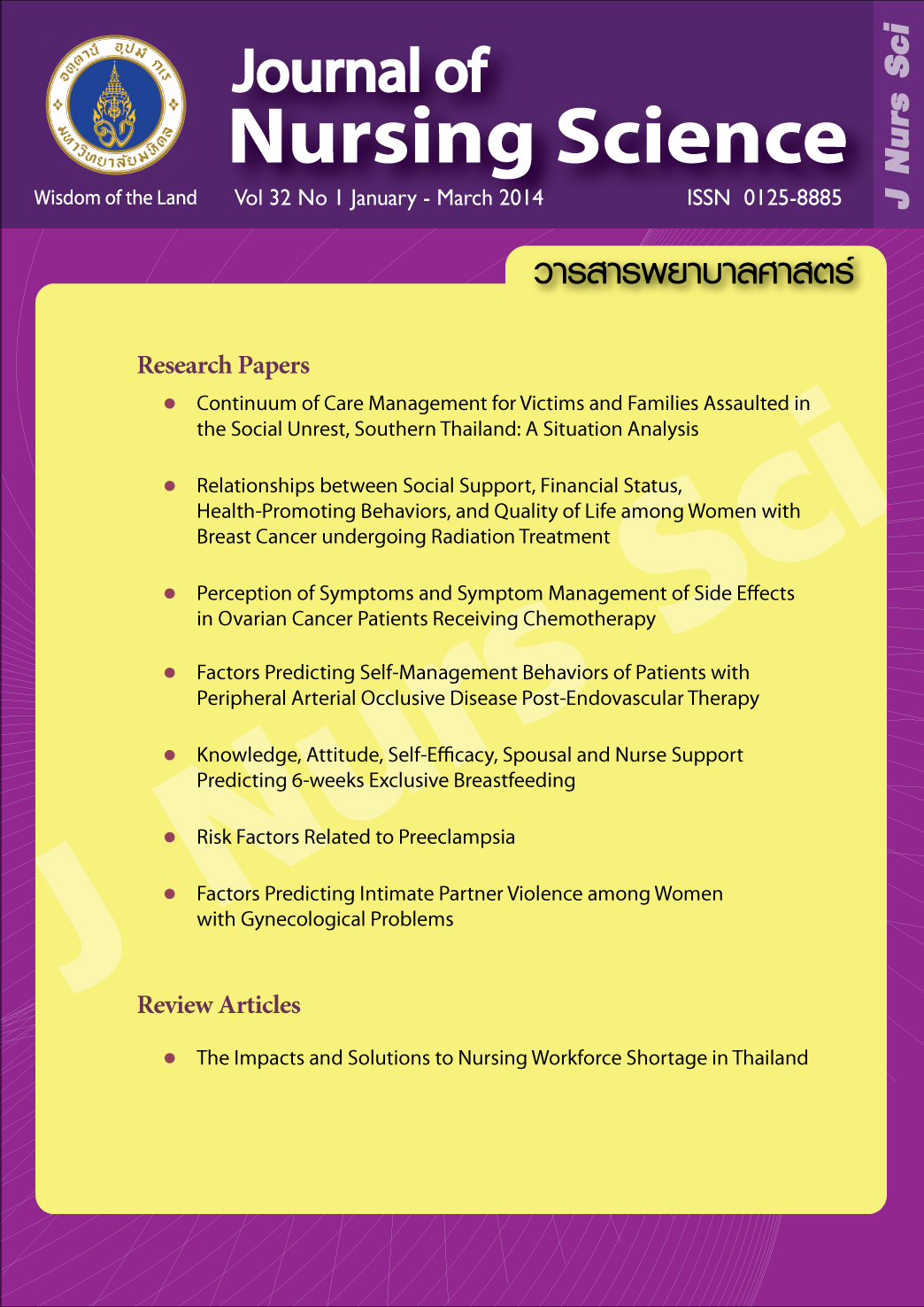Relationships between Social Support, Financial Status, Health-Promoting Behaviors, and Quality of Life among Women with Breast Cancer undergoing Radiation Treatment
Main Article Content
Abstract
Purpose: To study health-promoting behaviors and the relationships between social support, financial status, health-promoting behaviors, and quality of life among women with breast cancer undergoing radiation treatment.
Design: Descriptive correlational research.
Methods: The study sample consisted of 88 women diagnosed with breast cancer who were receiving radiation therapy at radiation department of one university hospital in Bangkok. The subjects were recruited by convenience sampling. Data were collected using 1) Personal and Demographic Questionnaire, 2) the Multi-dimensional Scale of Perceived Social Support, 3) Health Promotion Lifestyle Profile II, and 4) Functional Assessment of Cancer Therapy-Breast Scale (FACT-B). Data were analyzed using descriptive statistics, Pearson’s Moment Product correlation, and Spearman’s rank correlation.
Main findings: Health-promoting behaviors scores of breast cancer women undergoing radiation treatment were considered low (X = 141.77, SD = 21.12) when compared to those who received chemotherapy in a previous study (X = 164.40, SD = 20.9). Quality of life was positively correlated with health-promoting behaviors (r = .47, p < .01), social support (r = .46, p < .01) and financial status (r = .36, p < .01). Health-promoting behaviors were positively correlated with social support (r = .50, p < .01), but not correlated with financial status.
Conclusion and recommendations: Nurses should assess health-promoting behaviors and sources of social support of women with breast cancer during radiation treatment. Quality of life should also be assessed in those patients with low income in order to make nursing care plan for promoting health and quality of life in women with breast cancer during treatment.
ความสัมพันธ์ระหว่างการสนับสนุนทางสังคม สถานภาพทางการเงิน พฤติกรรมสร้างเสริมสุขภาพ และคุณภาพชีวิตในสตรีมะเร็งเต้านมระหว่างได้รับรังสีรักษา
คนึงนิจ พงศ์ถาวรกมล, พิจิตรา เล็กดำรงกุล, พรพรรณ วนวโรดม, วันทกานต์ ราชวงศ์
บทคัดย่อ
วัตถุประสงค์: ศึกษาพฤติกรรมสร้างเสริมสุขภาพและความสัมพันธ์ระหว่างการสนับสนุนทางสังคม สถานภาพทางการเงิน พฤติกรรมสร้างเสริมสุขภาพ และคุณภาพชีวิตในสตรีมะเร็งเต้านมระหว่างได้รับรังสีรักษา
รูปแบบการวิจัย: การศึกษาความสัมพันธ์เชิงพรรณนา
วิธีดำเนินการวิจัย: กลุ่มตัวอย่างเป็นสตรีที่ได้รับวินิจฉัยเป็นมะเร็งเต้านมที่มารับการรักษา ณ หน่วยรังสีรักษาของโรงพยาบาลมหาวิทยาลัยแห่งหนึ่งในกรุงเทพฯ จำนวน 88 ราย ใช้วิธีเลือกกลุ่มตัวอย่างแบบสะดวก รวบรวมข้อมูลโดยใช้ 1) แบบบันทึกข้อมูลส่วนบุคคล 2) แบบวัดการรับรู้แรงสนับสนุนทางสังคมพหุมิติ 3) แบบวัดพฤติกรรมสร้างเสริมสุขภาพ และ 4) แบบวัดคุณภาพชีวิตผู้ป่วยมะเร็งเต้านม วิเคราะห์ข้อมูลโดยใช้สถิติเชิงพรรณนา และการวิเคราะห์ความสัมพันธ์ โดยใช้ค่าสัมประสิทธิสหสัมพันธ์เพียร์สันและค่าสหสัมพันธ์สเพียร์แมน
ผลการวิจัย: คะแนนพฤติกรรมสร้างเสริมสุขภาพโดยรวมของกลุ่มตัวอย่างสตรีมะเร็งเต้านมระหว่างได้รับรังสีรักษามีค่าเฉลี่ยค่อนข้างต่ำ (X = 141.77, SD = 21.12) เมื่อเปรียบเทียบกับกลุ่มสตรีมะเร็งเต้านมระหว่างการรักษาด้วยเคมีบำบัดในการศึกษาที่ผ่านมา (X = 164.40, SD = 20.9) คุณภาพชีวิตโดยรวมมีความสัมพันธ์เชิงบวกกับพฤติกรรมสร้างเสริมสุขภาพ (r = .47, p < .01) การสนับสนุนทางสังคม (r = .46, p < .01) และสถานภาพทางการเงิน (r = .36, p < .01) พฤติกรรมสร้างเสริมสุขภาพมีความสัมพันธ์เชิงบวกกับการสนับสนุนทางสังคม (r = .50, p < .01) แต่ไม่สัมพันธ์กับสถานภาพทางทางการเงิน
สรุปและข้อเสนอแนะ: พยาบาลควรประเมินพฤติกรรมสร้างเสริมสุขภาพ และแหล่งสนับสนุนทางสังคมของสตรีมะเร็งเต้านมระหว่างได้รับรังสีรักษา ในกลุ่มผู้ป่วยสถานภาพทางการเงินไม่ดีควรพิจารณาประเมินคุณภาพชีวิตด้วยเพื่อนำไปสู่การวางแผนการพยาบาลที่ส่งเสริมภาวะสุขภาพและคุณภาพชีวิตที่ดีของสตรีมะเร็งเต้านมระหว่างได้รับรังสีรักษา
คำสำคัญ: การสนับสนุนทางสังคม สถานภาพทางการเงิน พฤติกรรมสร้างเสริมสุขภาพ คุณภาพชีวิต มะเร็งเต้านม
Article Details
Copyright Notice: Nursing Science Journal of Thailand has exclusive rights to publish and distribute the manuscript and all contents therein. Without the journal’s permission, the dissemination of the manuscript in another journal or online, and the reproduction of the manuscript for non-educational purpose are prohibited.

Disclaimer: The opinion expressed and figures provided in this journal, NSJT, are the sole responsibility of the authors. The editorial board bears no responsibility in this regard.

